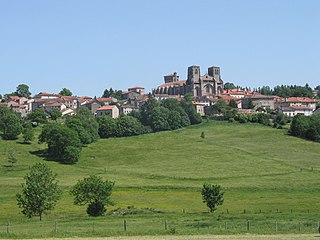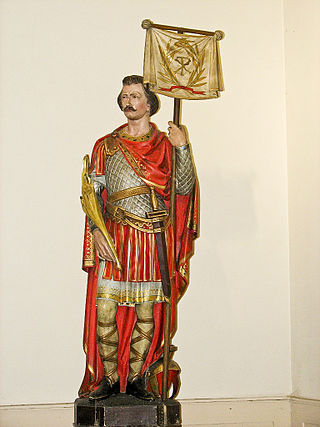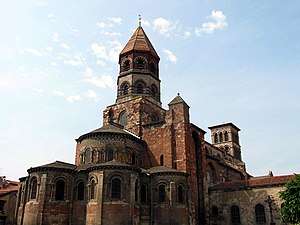
Haute-Loire is a landlocked department in the Auvergne-Rhône-Alpes region of south-central France. Named after the Loire River, it is surrounded by the departments of Loire, Ardèche, Lozère, Cantal and Puy-de-Dôme. In 2019, it had a population of 227,570; its inhabitants are called Altiligériens in French.

The following is a list of the 257 communes of the Haute-Loire department of France.
The history of Toulouse, in Occitania, southern France, traces back to ancient times. After Roman rule, the city was ruled by the Visigoths and Merovingian and Carolingian Franks. Capital of the County of Toulouse during the Middle Ages, today it is the capital of the Midi-Pyrénées region.

Le Puy-en-Velay is the prefecture of the Haute-Loire department in the Auvergne-Rhône-Alpes region of south-central France.

Auvergne is a cultural region in central France.

The history of the Auvergne dates back to the early Middle Ages, when it was a historic province in south-central France. It was originally the feudal domain of the Counts of Auvergne.

La Chaise-Dieu is a commune in the Haute-Loire department in south-central France. Its inhabitants are called Casadéens, from the Latin name of the city.

The 3 arrondissements of the Haute-Loire department are:
- Arrondissement of Brioude, with 111 communes. The population of the arrondissement was 45,768 in 2016.
- Arrondissement of Le Puy-en-Velay, with 102 communes. The population of the arrondissement was 96,498 in 2016.
- Arrondissement of Yssingeaux, with 44 communes. The population of the arrondissement was 85,073 in 2016.

The Arrondissement of Brioude is an arrondissement of France in the Haute-Loire department in the Auvergne-Rhône-Alpes region. It has 111 communes. Its population is 45,768 (2016), and its area is 1,886.8 km2 (728.5 sq mi).

The arrondissement of Le Puy-en-Velay is an arrondissement of France in the Haute-Loire department in the Auvergne-Rhône-Alpes region. It has 102 communes. Its population is 96,498 (2016), and its area is 1,930.7 km2 (745.4 sq mi).

The arrondissement of Yssingeaux is an arrondissement of France in the Haute-Loire departement in the Auvergne-Rhône-Alpes region. It has 44 communes. Its population is 85,073 (2016), and its area is 1,159.7 km2 (447.8 sq mi).

The Diocese of Le Puy-en-Velay is a Latin diocese of the Catholic Church in France. The diocese comprises the whole Department of Haute-Loire, in the Region of Auvergne-Rhône-Alpes. The diocese is a suffragan of the Archdiocese of Clermont.

Saugues is a commune in the Haute-Loire department in south-central France.

Vazeilles-Limandre is a commune in the Haute-Loire department in south-central France in the region Auvergne.

UNESCO designated the Routes of Santiago de Compostela in France as a World Heritage Site in December 1998. The routes pass through the following regions of France: Aquitaine, Auvergne, Basse-Normandie, Bourgogne, Centre, Champagne-Ardenne, Ile-de-France, Languedoc-Roussillon, Limousin, Midi-Pyrénées, Picardie, Poitou-Charentes, and Provence-Alpes-Côte d'Azur. UNESCO cites the routes' role in "religious and cultural exchange", the development of "specialized edifices" along the routes, and their "exceptional witness to the power and influence of Christian faith among people of all classes and countries in Europe during the Middle Ages".

Saint Julian of Brioude (†304) was a legendary martyr and saint from the Auvergne region of France. Although the main focus of his cultus was in the small village of Brioude, he was originally from the city of Vienne, and also associated with Clermont. He was most famous through his association with an aristocratic family of bishops of the time, his most notable proponents being St. Gallus of Clermont and St. Gregory of Tours. Gregory wrote a vita of Julian, but his attempts to expand the saint's cult from the Auvergne to Touraine and Aquitaine were unsuccessful, and Julian is now only remembered through his basilica in the town of Brioude itself.
Communauté d'agglomération du Puy-en-Velay is the communauté d'agglomération, an intercommunal structure, centred on the town of Le Puy-en-Velay. It is located in the Haute-Loire department, in the Auvergne-Rhône-Alpes region, south-central France. Created in 2017, its seat is in Le Puy-en-Velay. Its area is 1324.0 km2. Its population was 82,871 in 2019, of which 19,215 in Le Puy-en-Velay proper.

The Basilica of Saint-Julian of Brioude is a basilica of the Auvergne Romanesque style located in the territory of the French commune of Brioude, in the department of Haute-Loire in the Auvergne-Rhône-Alpes region. It is classified as a historical monument.

Brivadois is a natural region of France and a traditional country of Auvergne located to the west of the department of Haute-Loire and in a small part of Puy-de-Dôme and Cantal.





















